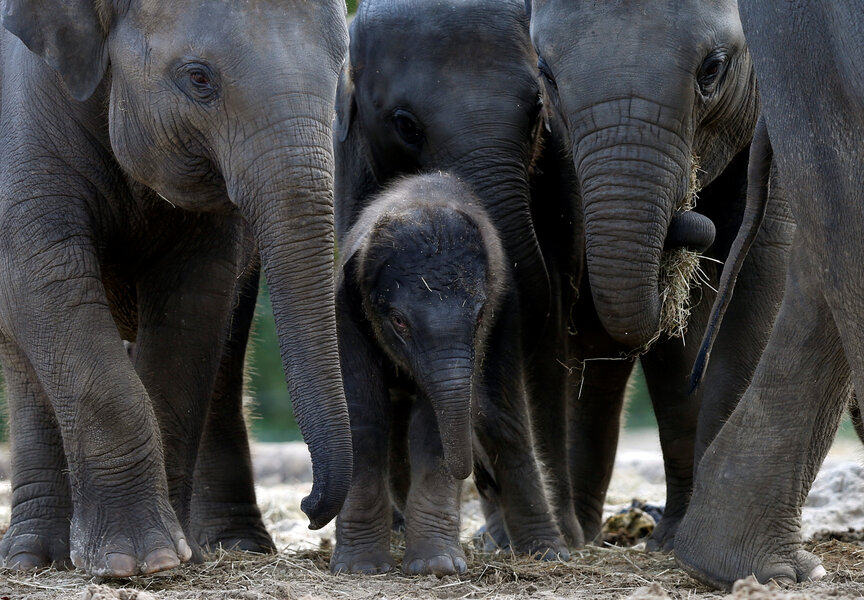A steady forward march for captive elephants
Loading...
When Ulara Nakagawa saw the 69-year-old elephant Hanako at Tokyo’s Inokashira Park Zoo in 2015, she knew she had to do something.
“At first glance, I mistook her for a statue. Then I saw her move a bit, and realized it was living creature. I was devastated,” says Ms. Nakagawa. Hanako had lived alone in a small concrete enclosure almost her entire life, leading some to call her “The Loneliest Elephant in the World.”
Nakagawa started an online petition to send Hanako to an elephant sanctuary. But when it was just shy of half-a-million signatures in March 2016, Hanako died. Nakagawa started the organization Elephants in Japan in Hanako’s honor to improve elephants’ lives.
Nakagawa’s urgent efforts mirror a growing worldwide awareness of the plight of captive pachyderms that is starting to translate to changes in zoo policies. Those shifts are gradual, experts say. They run from a growing willingness to improve enclosures to the shuttering of such enclosures altogether.
“There are indications that some change is happening. [But] there is more … we could be doing,” says Jonathan Balcombe, an expert on animal behavior and a director with the Humane Society Institute for Science and Policy. “We’re in an era with an unprecedented level of moral concern for the wellbeing of animals.”
And the fight against performing captive elephants has seen specific success, say experts like Mr. Balcombe and Ed Stewart, president of the Performing Animal Welfare Society (PAWS).
The 146-year-old Ringling Bros. and Barnum & Bailey traveling circus ended its elephant act in 2016 due to activist protests, and then shut down production completely earlier this year due to declining ticket sales. New York Gov. Andrew Cuomo signed the Elephant Protection Act into law last month, making New York the second state after Illinois to legally prohibit the use of elephants for entertainment, such as circuses. New York City Mayor Bill de Blasio signed a similar citywide bill this summer.
Mr. Stewart says public concern about elephants is “accelerating” every day.
“With social media now you can figure out what is going on almost anywhere. The underpinning of captivity is falling apart,” says Stewart. “I think in 20 years we’ll look back and think ‘Wow, we locked animals up in cages for no reason.’”
Between 2004 and 2005, the Chehaw Wild Animal Park in Georgia, the San Francisco Zoo, and the Detroit Zoo all ended their elephant exhibits for ethical reasons, sending their combined six elephants to sanctuaries. The Buttonwood Park Zoo in New Bedford, Mass., the Bronx Zoo in New York, and the Point Defiance Zoo and Aquarium in Tacoma, Wash., all say they will end their elephant exhibits when their current elephants pass away.
And the US isn’t alone: India’s Central Zoo Authority prohibited elephants in zoos or circuses in 2009, the country’s 140 captive elephants were transferred to national parks or reserves. In 2013 the Toronto Zoo ended its elephant program and transferred two African elephants to the PAWS facility in San Andreas, Calif. And just last year the Mendoza Zoological Park in Argentina transferred four elephants to a sanctuary in Brazil.
The tide could be turning in Japan as well, says Keith Lindsay, a Canadian-British conservation biologist who has studied elephants for more than 30 years.
Inspired by Nakagawa’s story of Hanako, Dr. Lindsay partnered with Elephants in Japan and the Canada-based organization ZooCheck to publish a report on the living conditions of 14 other solitary elephants in zoos across the country.
“This concern over one particularly tragic case opens the window on wider issues of elephant keeping in Japan, as the public grows ever more aware of the need to consider the welfare of all animals,” says Lindsay in his June report. He is hopeful that international attention from the 2020 Tokyo Olympics will pressure the remaining 51 Japanese zoos with elephants to either improve living conditions or end their exhibits.
“Visitors from the outside will see the animals and comment on it. It’s an added incentive for Japan to do something,” says Lindsay. “I’m cautiously optimistic.”
Kaori Sakamoto, a Japan-based advocate for zoo animals, told The Japan Times that many zoos have already read Lindsay’s report and started making modifications.






